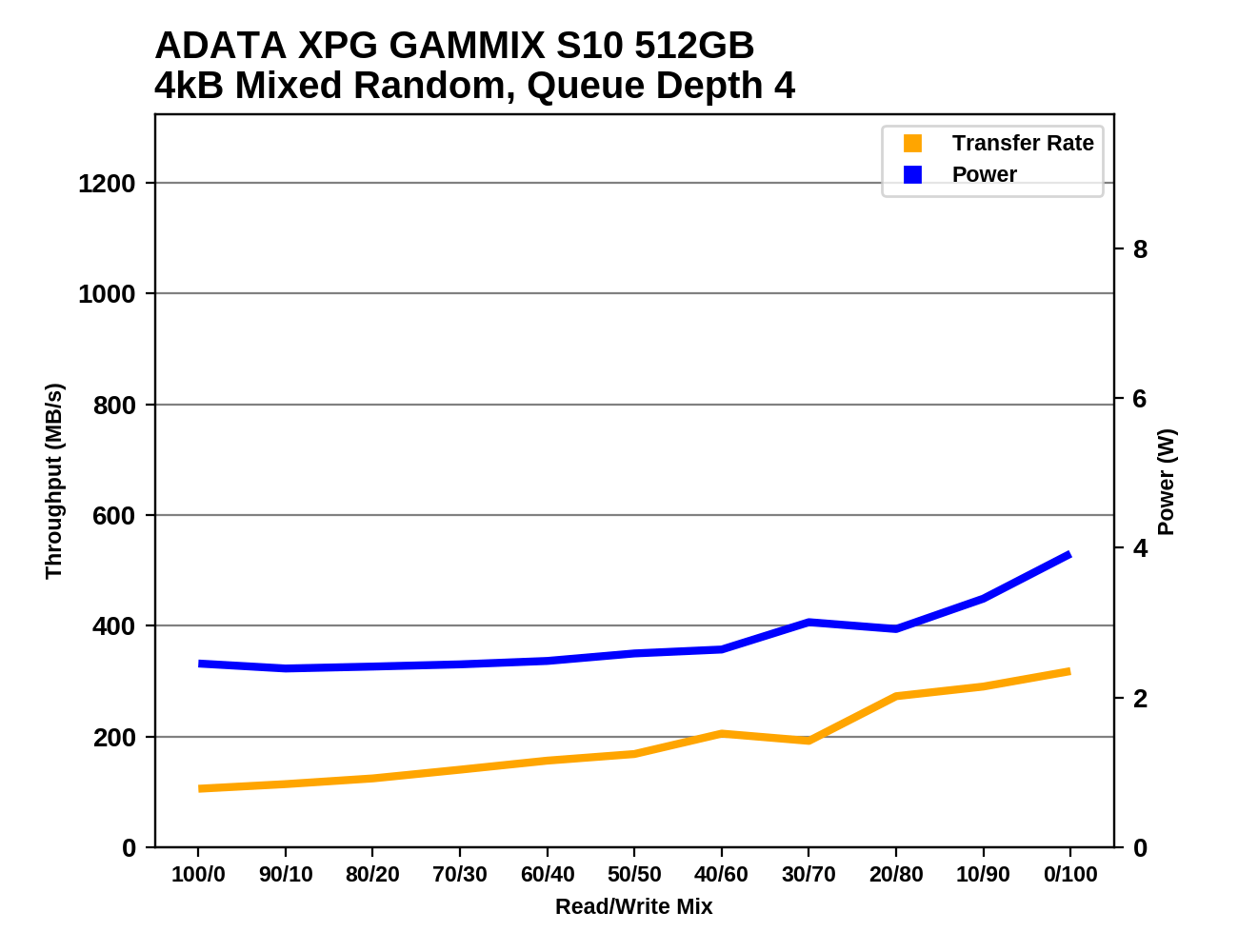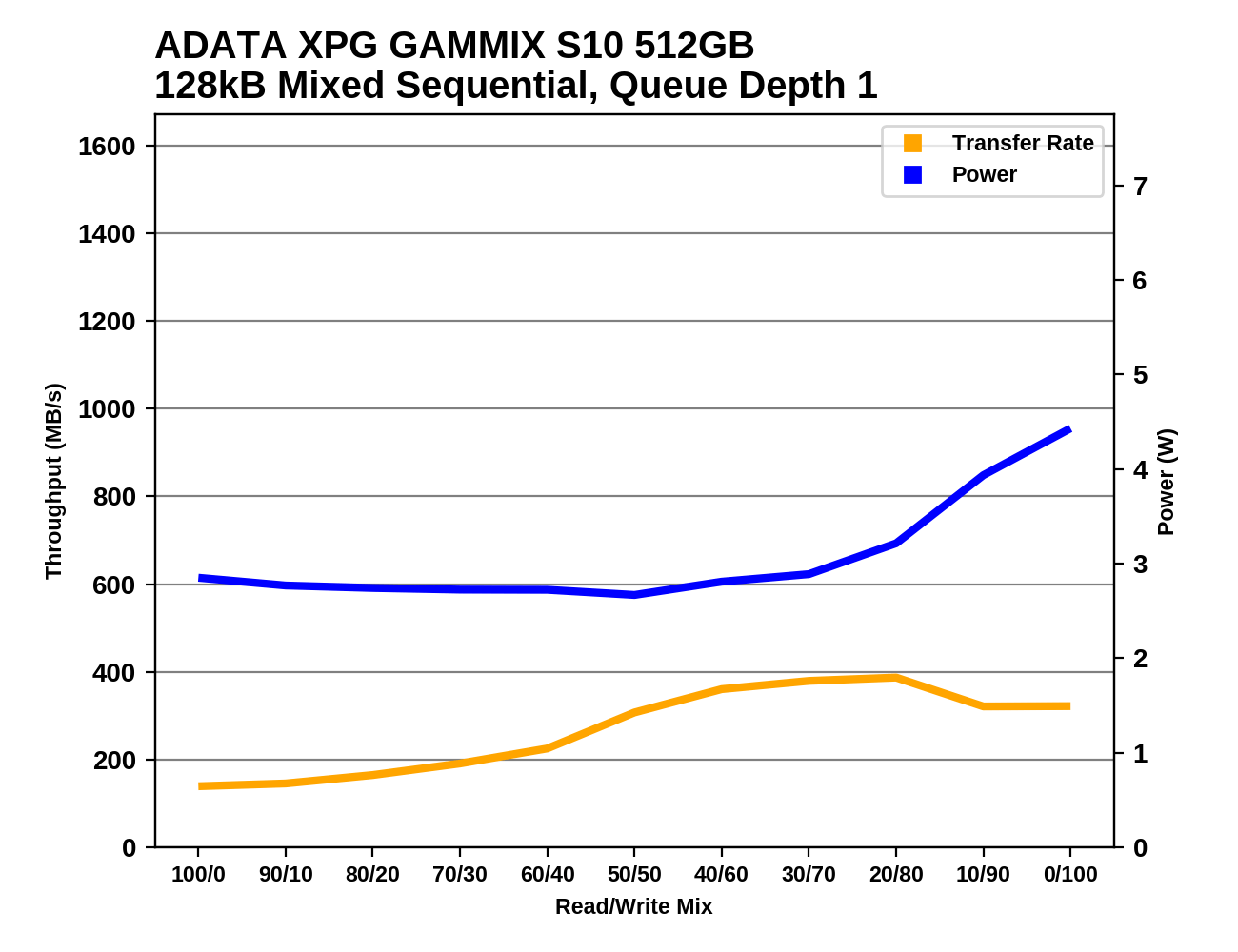The ADATA XPG GAMMIX S10 (512GB) SSD Review: Entry-Level NVMe With Style
by Billy Tallis on October 25, 2017 8:30 AM ESTMixed Random Performance
Our test of mixed random reads and writes covers mixes varying from pure reads to pure writes at 10% increments. Each mix is tested for up to 1 minute or 32GB of data transferred. The test is conducted with a queue depth of 4, and is limited to a 64GB span of the drive. In between each mix, the drive is given idle time of up to one minute so that the overall duty cycle is 50%.

The ADATA XPG GAMMIX S10 doesn't quite outperform every SATA SSD on the mixed random I/O test, but it comes close. The performance is respectable for a TLC-based SSD and is a substantial improvement over the Intel 600p.

The power efficiency of the GAMMIX S10 beats most of the TLC-based NVMe SSDs, but that is the least efficient product segment in general.
 |
|||||||||
The performance of the ADATA XPG GAMMIX S10 generally increases as the portion of writes in the random I/O workload grows, but the SLC cache does fill up and cause some trouble. The GAMMIX S10 is also unable to use its caching to deliver a much higher level of performance in the final phase of the test when the workload consists purely of random writes.
Mixed Sequential Performance
Our test of mixed sequential reads and writes differs from the mixed random I/O test by performing 128kB sequential accesses rather than 4kB accesses at random locations, and the sequential test is conducted at queue depth 1. The range of mixes tested is the same, and the timing and limits on data transfers are also the same as above.

The ADATA XPG GAMMIX S10 was near last place on both the sequential read and write tests, so it is no surprise to see it once again near the bottom of the chart on this mixed sequential I/O test. On average, a typical mainstream SATA SSD will offer better sequential I/O performance.

As with performance, the power efficiency of the GAMMIX S10 on the mixed sequential write test is second worst. The WD Black is significantly slower and less efficient, while the gap between the GAMMIX S10 and the Intel 600p is quite small.
 |
|||||||||
As with the random mixed I/O test, the mixed sequential I/O test fills the caches of the GAMMIX S10, leading to lower and less consistent performance toward the end of the test, after a first half showing modest performance increases.










27 Comments
View All Comments
Flunk - Wednesday, October 25, 2017 - link
Even a proper heatspreader doesn't cool the underlying components, to do that you need fins to dissipate heat. Add fins to a heatspreader then you have a heatsink. I'm not saying heatspeaders are worthless, but they don't do much unless attached to something else.ddriver - Wednesday, October 25, 2017 - link
The heatspreader will work, if it has good contact with the chip, which it doesn't.The purpose of the heat spreader is ... well... to spread heat. This gives you more surface to displace heat. Fins serve to increase the head-spreading effect further, although for this product in particular I doubt fins are necessary. In fact, as I mentioned above, the way the heatspreader is implemented and the pathetic performance itself suggest that the cooling solution is 100% unneeded, and present purely for cosmetic purposes.
znd125 - Wednesday, October 25, 2017 - link
Information on the die/channel configuration is lacking in many SSD reviews by Billy Tallis. This information is especially important for SSDs using non-power-of-2 density NAND chips, which often result in awkward die/channel configurations that consequently lead to low performance. Tallis rarely discusses this.It is not enough to simply state "... severely reduced performance potential due to not being able to populate every channel of the controller with NAND flash chips". I expect more from AT articles. If not every, how many channels are populated? How many dies are in each channel? Are they evenly distributed? Tell us exactly how the channels are populated and then you can go on to judge whether that is good or bad.
As another example, Tom's Hardware in their Intel 600p review pointed out the drive was able to use only 6 of the 8 channels. Tallis did not. To me, that is not a trivial piece of information. That is THE reason the 600p does not reach its "performance potential" IMO.
Ratman6161 - Wednesday, October 25, 2017 - link
While I too would be interested to see the information you are seeking, I don't think its a critical flaw in the article. For those interested in making a buying decision, its the performance scores and the price and the price/performance equation that matter. Other information is useful if you want to know why one performs better than another. However, with nearly all SSD reviews these days, I usually end up just skimming through to the conclusion. If its a SATA drive, all I really want to know is where is its price/performance ration vs a Samsung 850 EVO. If its NVMe then the price/performance comparison is against the 960 EVO.However....here is something I really would like to see more of. When drives are tested I would like to see the same drive tested in different sizes...which is kind of getting into what you are talking about indirectly. For example, in all the charts you can see a pretty substantial difference between the 1TB and 250 GB 960 EVO's. It really would be nice to see a 512 GB in there. A drive that wins at 1 TB may not win at 512 GB. Unfortunately when I was buying the 512 is what was in my price range and I had to do some digging for information on that. THG actually did review all three sizes.
DanNeely - Wednesday, October 25, 2017 - link
Assuming the conclusion is right about next year's controllers being massively better than the current generation they can't get here soon enough. None of the controllers currently available to the down market OEMs are remotely competitive with samsung's last few generations of parts.MrSpadge - Sunday, October 29, 2017 - link
Adatas strategy seems to be: make many bad SSDs with fancy names and hope someones buys them by accident. Otherwise I can't explain this and the preceeding drives.